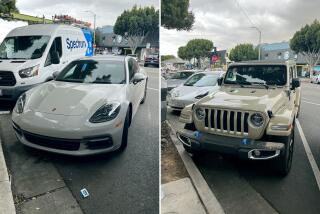Car-Paint Crazing Can Drive You Crazy
- Share via
Question: The finish on my car has developed fine white lines all over it. I was told it is called crazing. Short of having the car repainted, can I do anything to eliminate it? Somebody at the dealership suggested I try to use a rubbing compound to rub out the lines. Will that work?--L.S.
Answer: Crazing is a condition in which hairline cracks develop in the clear coat of two-stage paints, which are widely used on both domestic and imported cars.
Two-stage paints have a color coat and a clear coat of paint, in addition to a primer coat on the bare metal. The clear coat is intended to give the paint a luster and depth that appeals to new-car buyers.
The experience with these paint systems as cars age, however, is definitely mixed. They often deteriorate badly, requiring a repainting within four to six years, far short of the expected life of the car.
Crazing is one widely reported problem. It is similar to what you would have with a cracked mirror. The glass may be cracked in a pattern like a spider web, but the underlying silver is intact. In the case of a car, the glass is the clear coat and the silver is the paint.
The clear coat on an automobile is only about 1.5 millimeters thick, or .0015 of an inch. A page of a newspaper is about 1 mil or one thousandth of an inch thick, by comparison.
The crazing may go through the full thickness of the clear coat and even through the paint and primer. In some cases, the underlying metal will rust in patterns that duplicate the crazing. If that happens, you should repaint the car as soon as possible.
The white lines you are seeing result from light that is reflected by the cracked surface. The polish may remove the worst parts of the cracks and result in a smoother finish that will reflect less light.
But you will probably never eliminate the crazing, because it goes through the clear coat. The crazing you reduce may quickly reappear. In fact, the use of a polishing compound may even cause the paint to deteriorate more quickly than if left alone.
Rubbing out a car is very hard work, especially if you attempt to do it by hand. You would need to use a heavy-duty rubbing compound and a finishing-polishing compound. It is easy to cut through the paint and ruin it. The risk is even higher if you use power-tool equipment.
On a final note, not all white lines in paint are crazing. Sometimes, the clear coat can become easily scratched because it is too soft. Even wind can scratch it. In these cases, a polishing may help in restoring the paint.
Q: With ski season fast approaching, I need to know whether I should put my tire chains on the front or rear tires on my four-wheel-drive Toyota. I have heard conflicting advice.--J.R.R.A.
A: If you use only one set of chains on a four-wheel-drive vehicle, they go on the rear wheels. If you put them on the front wheels of a four-wheel-drive vehicle, you will lose some steering effectiveness, and the chains will tend to pull off the tires.
You can use four sets of chains, but you generally don’t need them. If you do need them, you had better be experienced in snow driving.
Of course, front-wheel-drive cars take chains on the front wheels. The rule is to put the chains on the primary drive axle for the car. In the case of four-wheel-drive cars, that is the rear axle.
Ralph Vartabedian cannot answer mail personally but will respond in this column to automotive questions of general interest. Do not telephone. Write to Your Wheels, You section, The Times, Times Mirror Square, Los Angeles 90053.







